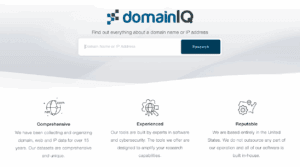What is AI Domain – And Does the .ai TLD Work for Your Business?
Super-popular since the launch of chatGPT, .ai domain names are an attractive option for tech and machine learning businesses. Domain name expert Joe Uddeme explains the pros and cons. The .ai domain extension is a top-level domain (TLD – check out our comprehensive guide to domain levels) that originated as the country code domain for Anguilla, a picturesque Caribbean island. Initially designated for local use, the .ai domain has since evolved far beyond its geographic roots. Today, it is recognized as a specialized domain extension tailored for companies involved in artificial intelligence and related technologies. The .ai domain stands as a beacon of innovation and technological prowess, particularly in the realms of artificial intelligence and technology. The .ai domain extension has become synonymous with cutting-edge advancements, making it a sought-after choice for businesses and organizations aiming to showcase their expertise in AI and related fields. In this post, we’ll look at the originals of the .ai TLD and discuss why it might be right for your business when you want to buy a premium domain name. Key Takeaways Origins of the .ai TLD What are the benefits of a sector-specific domain name? Popular .ai brands thriving today Is the .ai TLD safe? Brief History of AI Domain The .ai domain has a fascinating history that dates back to 1995, when it was introduced as the country code top-level domain (ccTLD) for the island of Anguilla. Initially, the domain was restricted to businesses based in or tied to Anguilla, but in 2009, it was made available worldwide without restrictions. Since then, the .ai domain has gained popularity among tech companies and organizations globally, representing artificial intelligence and innovation. Today, the .ai domain is a sought-after domain extension, with many to establish a strong online presence. AI Domain Names: Significance and Purpose AI domain names, which end with the .ai extension, are more than just web addresses—they are powerful tools for brand recognition and online presence. For tech companies and organizations, a .ai domain name signals a commitment to innovation and technological excellence. These domain names are particularly valuable for businesses in the AI sector, as they instantly convey a focus on artificial intelligence. By choosing a .ai domain, companies can create a unique and memorable web address that reflects their dedication to advancing technology and AI. This not only helps in establishing a strong online identity but also in attracting a tech-savvy audience. The concept of ‘ai domain growth’ is closely tied to the adoption and future prospects of .ai domains, driven by factors such as innovation in AI technologies, the number of AI-focused startups, and the consumer perception of .ai branding. Benefits of .AI Domains SEO Benefits for AI-Related Topics One of the standout benefits of .ai domains is their potential to enhance search engine optimization (SEO) for AI-related content. Google treats certain country code top-level domains (ccTLDs), including .ai, similarly to generic top-level domains (gTLDs) like .com, .net, and .org. This means that a .ai domain can be just as effective in reaching users who are searching for AI-related information. By leveraging a .ai domain, businesses can improve their visibility in search engine results, thereby attracting more visitors interested in artificial intelligence. This SEO advantage, combined with the inherent brand recognition of the .ai extension, makes this kind of domain name branding a powerful asset for companies in the AI sector. Anyone involved in domain portfolio management today is quite likely to have one or more .ai domain names in their collection – if only for future-proofing reasons. Popular AI Domain Examples The .ai domain extension has been embraced by numerous influential companies and organizations within the tech industry. Here are some notable examples that showcase the versatility and appeal of this domain extension: Open.ai Open.ai is a pioneering research organization dedicated to advancing artificial intelligence to benefit humanity. Their website, open.ai, serves as a hub for their groundbreaking work and mission in the AI field. By using the .ai domain extension, Open.ai underscores its commitment to innovation and leadership in artificial intelligence. Facebook.ai Facebook.ai is the dedicated platform for Facebook’s extensive research and development in artificial intelligence. The website provides a comprehensive overview of Facebook’s AI initiatives, including their cutting-edge AI-powered tools and technologies. The .ai domain extension helps Facebook highlight its focus on AI advancements and its role in shaping the future of technology. AI.google AI.google is Google’s showcase for its artificial intelligence research and development efforts. The website offers detailed information on Google’s AI projects, tools, and technologies, reflecting the company’s dedication to pushing the boundaries of what AI can achieve. The .ai domain extension reinforces Google’s position as a leader in the AI industry. AI Domain vs Other Domain Extensions When it comes to choosing a domain extension, tech companies and organizations have several options, each with its unique advantages. The .ai domain stands out as a niche domain extension specifically associated with artificial intelligence and machine learning. While .com remains the most popular and widely recognized domain extension, .ai is rapidly gaining traction among businesses focused on cutting-edge technology. On the other hand, .io is another popular choice for tech companies, but it doesn’t carry the same strong association with AI as the .ai domain does. For businesses aiming to highlight their expertise in artificial intelligence, the .ai domain offers a distinct and memorable web address that sets them apart from the competition. (Need help securing a domain name that seems out of reach? Check out our guide to the top domain brokers for 2025). Comparison to .com Domain The .com domain is the most widely recognized and popular domain extension, with over 160 million registered domains. In contrast, the .ai domain has around 533,000 registered domains as of October 2024. While .com is a more established and traditional domain extension, .ai is gaining popularity as a niche domain extension for tech companies and organizations focused on artificial intelligence and machine learning. Google treats some ccTLDs, including .ai, .me, and .biz, the same way as .com, .net, and .org, making .ai a viable option for businesses looking to establish a strong online presence. Comparison to .io Domain The .io domain is a popular domain extension for tech companies, but it is not as closely associated with artificial intelligence as .ai. While .io is a more established domain extension, .ai is gaining traction as a niche domain extension for tech companies and organizations focused on artificial intelligence and machine learning. The .io domain has around 1.5 million registered domains, compared to the .ai domain’s 550,000. Why not check out our guide to choosing a domain name? It’s full of helpful tips and advice. Acquiring and Configuring an AI Domain Acquiring and configuring a .ai domain is a straightforward process. To register a .ai domain, you can search for available domain names on a domain registrar’s website and proceed to check out. The registration process typically involves verifying the availability of the domain name, choosing your registration term, and paying the registration fee. Once the registration is complete, the domain name will be registered and available for use. To configure your .ai domain, you can set up website hosting, email hosting, and other services to establish a strong online presence. By securing a .ai domain, businesses can effectively signal their commitment to innovation and technological advancement in the AI industry. AI Domain Safety and Security Features When it comes to online security, the .ai domain extension offers robust features to ensure a safe and reliable web presence. Here are some key safety and security measures associated with .ai domains: Overview of Safety Features Domain Name Dispute Resolution Policy: The .ai domain extension adheres to the Uniform Domain-Name Dispute-Resolution Policy (UDRP), providing a structured process for resolving disputes related to domain name registrations. This policy helps protect domain owners from potential conflicts and ensures fair resolution. Domain Name System Security Extensions (DNSSEC): The .ai domain extension supports DNSSEC, which adds an extra layer of security to domain name lookups. DNSSEC helps prevent certain types of cyber attacks, such as cache poisoning, by ensuring the authenticity of the DNS responses. Two-Factor Authentication: Many registrars offering .ai domain registrations provide two-factor authentication (2FA). This security feature requires users to verify their identity through an additional method, such as a mobile device, adding an extra layer of protection against unauthorized access. Domain Locking: Some registrars offer domain locking services, which prevent unauthorized changes to the domain name registration. This feature ensures that only authorized individuals can modify domain settings, reducing the risk of domain hijacking. WHOIS Protection: WHOIS protection services are available through some registrars, which hide the registrant’s contact information from public view. This feature helps protect domain owners’ privacy and reduces the risk of spam and identity theft. Overall, the .ai domain extension is a secure and reliable choice for businesses and organizations aiming to establish a strong online presence in the tech industry. With these comprehensive safety features, .ai domains provide peace of mind and robust protection against various online threats. Who Uses .AI Domains? .ai domains are embraced by a diverse array of businesses and organizations within the AI and technology sectors. Here are some of the key users: Tech Companies: Many tech companies opt for .ai domains to establish a robust online presence and enhance brand recognition. The .ai extension underscores their commitment to technological innovation. AI Startups: For AI startups, a .ai domain is a perfect fit. It conveys a sense of cutting-edge technology and forward-thinking, which is crucial for attracting investors and customers. Research Institutions: Universities and research institutions often use .ai domains to highlight their work in artificial intelligence. This helps in building a strong online presence and gaining recognition in the academic and research communities. Businesses with AI-Related Products or Services: Companies offering AI-driven products or services find .ai domains particularly beneficial. It helps them stand out in a crowded market and signals their expertise in AI. Domain consultants advise businesses on the best strategy when planning a domain name portfolio. Overall, .ai domains are a strategic choice for anyone looking to make a mark in the AI industry, providing a blend of SEO benefits, brand recognition, and a clear association with technological innovation. About the author Joe Uddeme is Director and Principal of Name Experts, one of the world’s leading domain name brokerage services. He has overseen domain name sales and acquisitions totaling more than $150 million and is renowned worldwide as a go-to expert in buying and selling premium domains – be they .com, .ai or something else from the vast domain name network. Contact us at: [email protected]






